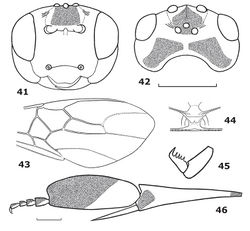Hartemita vietnamica
| Notice: | This page is derived from the original publication listed below, whose author(s) should always be credited. Further contributors may edit and improve the content of this page and, consequently, need to be credited as well (see page history). Any assessment of factual correctness requires a careful review of the original article as well as of subsequent contributions.
If you are uncertain whether your planned contribution is correct or not, we suggest that you use the associated discussion page instead of editing the page directly. This page should be cited as follows (rationale):
Citation formats to copy and paste
BibTeX: @article{Long2011ZooKeys102, RIS/ Endnote: TY - JOUR Wikipedia/ Citizendium: <ref name="Long2011ZooKeys102">{{Citation See also the citation download page at the journal. |
Ordo: Hymenoptera
Familia: Braconidae
Genus: Hartemita
Name
Hartemita vietnamica Long & van Achterberg, 2011 sp. n. – Wikispecies link – ZooBank link – Pensoft Profile
Type material
Holotype, female (IEBR), “Card.065”, “[NE Vietnam:] Vinh Phuc, Tam Dao NP, 100 m, MT, 30.v.2008, P. H. Thai”. Paratype: 1 male (RMNH), “Card.039”, “[CN Vietnam:] Nghe An, Con Cuong, Pu Mat NP, 22.iv.2006, P. Th. Nhi”.
Diagnosis
The new species is similar to Hartemita bruneiensis Dangerfield & Austin, but differs by having the occiput deeply excavate (weakly excavate in Hartemita bruneiensis; Fig. 66); vein 3-SR joining vein SR1 at 100° (90° in Hartemita bruneiensis); hind tibia yellow ventrally (dark brown ventrally; Fig. 67); hind claw with 3 teeth (4–7 teeth in Hartemita bruneiensis) and scutellum rugose-punctate (punctate in Hartemita bruneiensis).
Description
Holotype, male, body length 6.0 mm, fore wing length 6.8 mm, antenna 7.1 mm.
Head. Antennal segments 46 (paratype 44); third segment 1.25 times as long as fourth segment; length of third, fourth and penultimate segments 2.0, 1.6 and 1.0 times their width, respectively; eye glabrous, width of face 1.5 times height of eye; clypeal margin slightly concave medially (Fig. 41); epistomal suture distinct and curved; malar space 1.4 times width of mandible; in dorsal view head twice wider than its median length; occiput deeply concave (Fig. 42); temple behind eyes convex anteriorly and roundly narrowed posteriorly; length of temple nearly as long as transverse diameter of eye; OOL:POL:OD = 15:8:5; frons with a median carina (Fig. 42); face and clypeus sparsely punctate.
Mesosoma. Length of mesosoma 1.2 times its height; pronotal trough rugose dorsally, remainder of pronotal side smooth; notauli deep and crenulate anteriorly, nearly separated posteriorly by a carina; scutellar sulcus with 3 cross-carinae; mesoscutum punctate; scutellum rugose-punctate; median arch of metanotum with lateral cross-carinae (Fig. 44); mesopleuron smooth medially; precoxal sulcus shallow; mesosternum areolate-punctate; metapleuron and propodeum rugose.
Wings. Length of fore wing 2.7 times its maximum width; pterostigma length 4.0 times its median width; r:2-SR:3-SR = 10:15:35; second submarginal cell of fore wing length 3.4 times its maximum width; vein 1-CU1 0.4 times as long as vein 2-CU1; vein 3-SR joining vein SR1 at 100° (Fig. 43). Length of hind wing 3.9 times its maximum width; vein M+CU 0.4 times as long as vein 1-M.
Legs. Length of hind femur 5.2 times its width; hind basitarsus broadly laminate, slightly produced apically; length of hind tibia 3.5 times its apical width; hind basitarsus 2.7 times as long as wide (Fig. 46); hind basitarsus 1.3 times wider than apical width of hind tibia; inner hind tibial spur 0.5 times as long as hind basitarsus; second-fifth hind tarsal segments 0.4 times as long as hind basitarsus (Fig. 46); hind tarsal claw with 4 teeth (Fig. 45).
Metasoma. Second tergite shorter than third tergite.
Colour. Body and palpi yellow; antenna brown, but scapus yellow with dark brown spot apically and on outer side; frons black; vertex yellow anteriorly and black posteriorly (Fig. 42); middle and lateral lobes of mesoscutum black; mesosternum black dorsally and yellow ventrally; middle leg yellow, but outer side of trochantellus black; hind coxa dorso-apically, trochanter and trochantellus, basal ring of hind tibia, apical half of hind basitarsus dark brown or black; second-fifth hind tarsal segments dirty brown.
Female. Unknown.
Distribution
N Vietnam: Vinh Phuc and C Vietnam: Nghe An.
Etymology
The species is named after the country of origin: Vietnam.
Additional Vietnamese species
Original Description
- Long, K; van Achterberg, C; 2011: Review of the genus Hartemita Cameron, 1910 (Hymenoptera, Braconidae, Cardiochilinae), with the description of six new species from Vietnam ZooKeys, 102: 19-46. doi
Images
|
- ↑ Dangerfield P, Austin A (1990) Revision of the Oriental genus Hartemita Cameron (Hymenoptera: Braconidae: Cardiochilinae). Journal of Natural History 24:137-158. doi:10.1080/00222939000770091
- ↑ Belokobylskij S (2005) First record of the genus Hartemita Cameron from Russia with description of a new species from the south of the Russian Far East (Hymenoptera: Braconidae, Cardiochilinae). Zoosystematica Rossica 14 (1):129-133.

![Figures 65–74. 65–67. Hartemita bruneiensisDangerfield & Austin, male, holotype. 68–71. Hartemita singaporensis (Mao), female. 72–74. Hartemita spasskensisBelokobylskij, female, holotype. 65 mesonotum and metanotum dorsal 68, 72 head frontal 66, 69, 73 head dorsal 67, 71, 74 hind tibia and tarsus lateral 70 hind tarsal claw. Figures 65–69, 71 after Dangerfield and Austin (1990)[1] and 72–74 after Belokobylskij (2005)[2]](/w/media/thumb/c/cf/ZooKeys-102-019-g010.jpg/178px-ZooKeys-102-019-g010.jpg)